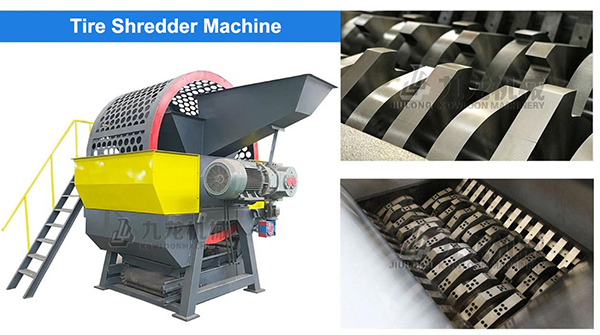
Tel/Whatsapp:+86 15649675999
Email:sale@kowloonmachine.com

Tel/Whatsapp:+86 15649675999
Email:sale@kowloonmachine.com
Article published:2023-10-12
The difference between waste tire shredder and waste tire shredder
In the field of waste tire processing, shredders and crushers are common equipment, but their working principles and uses are obviously different. This article will explore the features of both devices in detail to give readers a better understanding of their differences.
1. Working principle
The waste tire shredder mainly uses physical methods such as biting, squeezing, and shearing to gradually break waste tires into small pieces or fragments. Its working principle is similar to that of animals chewing food, and the rotating blades chew up the tires. At the same time, the shredder also has the functions of screening and dust removal, which can classify and filter the crushed tire blocks to remove metal and impurities.
In contrast, waste tire crushers break waste tires into finer particles or powder through physical methods such as impact, rolling, and grinding. Its working principle is similar to that of an ore crusher. The high-speed rotating hammer head impacts and grinds the tire into smaller pieces. At the same time, the crusher also has dust removal and drying functions, which can clean and dry the crushed tire fragments.

2. Application scope
Due to different working principles, the application ranges of waste tire shredders and waste tire shredders are also different. The crusher is mainly used to break waste tires into larger blocks or fragments. It is suitable for occasions where large-scale crushing of tires is required, such as waste tire retreading, recycled rubber production, etc.
The crusher is mainly used to break waste tires into finer particles or powder. It is suitable for occasions where more fine crushing of tires is required, such as recycled rubber production, fuel oil production, etc. At the same time, the crusher can also be used to process other waste materials, such as waste plastics, waste wood, etc.
3. Output and energy consumption
The output and energy consumption of waste tire shredders and waste tire shredders are also different. The output of a shredder is relatively small, usually between a few hundred kilograms to several tons per hour, while the output of a crusher is relatively large, usually between a few tons to dozens of tons per hour.
In addition, the energy consumption of the shredder is relatively low because its working principle is relatively simple and mainly relies on physical force for crushing, while the energy consumption of the crusher is relatively high because it requires a high-speed rotating hammer head to impact and crush the tires. Grinding requires more energy.
4. Treatment effect
The processing effects of waste tire shredders and waste tire shredders are also different. The tire blocks processed by the shredder are larger, have a rough surface, and sometimes contain metal and impurities, and require secondary processing or screening. The tire particles or powder processed by the crusher are smaller and have a smooth surface, and can be directly used in the production process.
In addition, the shredder is not as effective as the crusher in processing some hard waste materials, because it mainly bites and crushes rubber materials, and its crushing effect on hard materials is limited. The crusher can be applied to various types of waste materials, and the crushing effect is more comprehensive.
In summary, although waste tire shredders and waste tire shredders are both equipment in the field of waste tire processing, their working principles, application scope, output and energy consumption, and processing effects are obviously different. When choosing equipment to use, you need to make a choice based on specific needs and actual conditions.